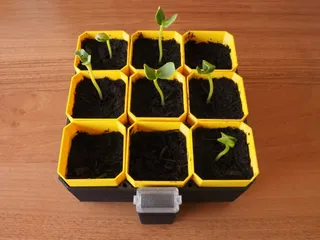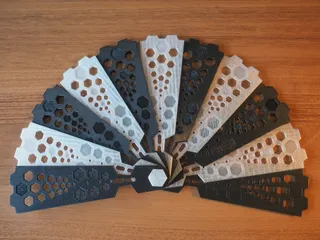Parametric Seed Starter
Description
PDFUpdates
- 09-12-2023: Fixed several basin parameters & updated to Blender 4.0.
Updated Files
- Parametric Seed Starter.blend
- 18-07-2023: Added a mid-section to the air-pruning strips in the cups.
Updated Files
- SeedStarter_0.4n
- SeedStarter_0.6n
- Parametric Seed Starter.blend
- 05-07-2023: Added Air-Pruning Strips option to the cups.
New Parameters
- Use Air-Pruning Strips
- Air-Pruning Height Ratio
Updated Files
- SeedStarter_0.4n
- SeedStarter_0.6n
- Parametric Seed Starter.blend
- 15-03-2023: Removed linked library in blend file & unused parameter drivers.
Updated Files
- Parametric Seed Starter.blend
- 11-03-2023: Added new parameters for the basin & added wall holes for the enclosed cover.
New Parameters
- Remove the fill port
- Round or square fill port
- Depth of the square fill port
Updated Files
- All BasinCovers(Enclosed)
- Parametric Seed Starter.blend
- 01-03-2023: First upload
Parts
The seed starter consists of 4 different parts. The main parts are the basin and the growing cups. The covers for the basin and the reservoir are optional. I recommend printing the main parts first to start growing your seeds.
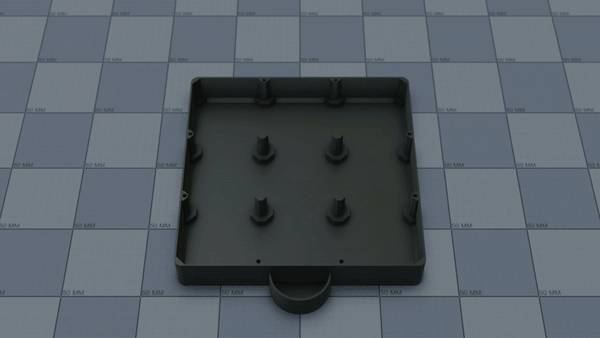
You can find the blend file I used to create this parametric design with the files. This design is made using the new geometry nodes functionality in Blender 3.4. To adjust the parts to fit your needs, you'll need Blender 4.0 and up.
Basin
The basin holds all the cups and serves as a reservoir. At the front is a fill port for the bay. This allows you to refill the reservoir as needed. It includes a water level indicator showing the cup standoffs' height. This helps prevent overwatering by ensuring the water level in the basin doesn't reach the growing medium of the cups, which can cause damage to your seedlings. An optional reservoir cover can be printed to prevent water from evaporating.

The parameters for the basin will let you change the following features:
- Amount Width
- Amount Length
- Height
- Wall Thickness
- Wall Tolerance (Distance between the cups and the inner wall)
- Fill Height
- Fill Port Height
I recommend a minimum of 3 perimeters of wall thickness for the basin to ensure everything is watertight. So if you use a nozzle size of 0.4 mm, a minimum of 1.2 mm would be thick enough to make it rigid and waterproof.
Cup
The cup is elevated by its four corners for better root access to the water and improved aeration. This method depends on the evaporation of water to allow enough moisture to reach the growing medium, to keep the seedlings happy and encourage the growth of roots.
I recommend thinning the walls to ensure flexibility, making transplanting the seedlings easier. Around 1mm with a 0.4mm nozzle should do the trick.
Each of the cups can easily be removed individually.
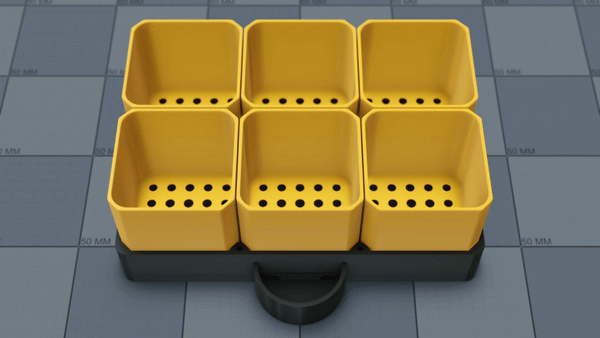
The parameters for the cups will let you change the following features:
- Width
- Length
- Height
- Thickness
- Min Hole Radius
- Max Hole Radius
- Hole Density
- Use Air-Pruning Strips (Cuts holes in the four corners)
- Air-Pruning Height Ratio
Covers (Optional)
For the basin cover, you can choose between two variants.
The enclosed cover will completely cover the basin and should be printed with a transparent filament so the seedlings can enjoy the extra light and heat.
The other option is the open cover. You can cover and enclose the frame using some basic plastic wrap, and this option also keeps moisture but leaks more heat because of the plastic wrapping—however, printing costs around 25% less plastic than the enclosed cover.
The parameters for the Basin Cover will let you change the following features:
- Enclosed / Open
- Height
- Thickness
- Frame Width
Fill Port Cover (Optional)
This cover is mainly cosmetic but prevents the exposed water from evaporating.
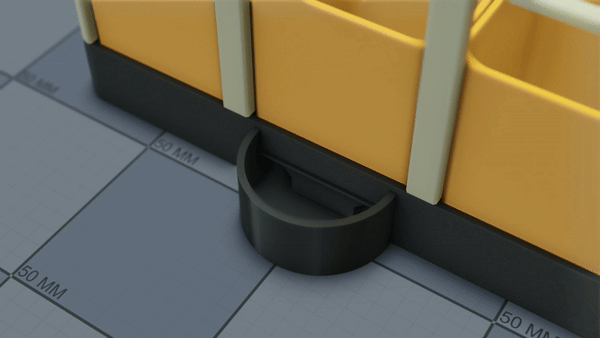
The parameters for the fill port will let you change the following features:
- Thickness
- Lip With
- Lip Length
- Wall Tolerance
Printing Difficulty: I
I: Novice printing knowledge
- Basic understanding of 3D printing principles and processes.
- Familiarity with operating a 3D printer.
- Able to follow step-by-step instructions for printing simple designs.
- Limited experience troubleshooting common printing issues.
II: Intermediate understanding
- Proficient in 3D printing principles and processes.
- Comfortable with various 3D printer settings and parameters.
- Capable of handling more complex designs and making necessary adjustments.
- Able to troubleshoot common printing issues and optimize print quality.
III: Experienced
- Extensive knowledge and expertise in 3D printing.
- Proficient in advanced printing techniques, such as multi-material or multi-colour printing.
- Skilled in fine-tuning printer settings for optimal results.
- Capable of handling complex and intricate designs.
- Experienced in troubleshooting and resolving various printing challenges.
Related Designs
If you want more prints to improve your gardening skills, check out the following design for helping your plants vertically in tight spaces and making compost using worms. https://www.printables.com/model/499011-flexigrowth-hooks
https://www.printables.com/model/140786-parametric-vermicomposter
Other Design
This is a redesign of an older self-watering seed starter kit. The new design improved a lot of aspects compared to the old one.
These are the most significant changes:
- The cup standoffs are moved to the corners and are integrated with the cup separators.
- The fill port holes are aligned to the cup standoffs, making them less prone to leaks.
- Added more chamfers to make it easier to clean
The old design can be found here:
https://www.printables.com/model/61902-small-self-watering-seed-starter
Filaments
For my print, I used the following filaments.
- PETG Recycled for the basin.
- PETG Prusament Terracotta Light for the cups.
- PVB Prusament Natural for the enclosed basin cover.
- PLA Prusament Vanilla White for the open basin cover.
Tags
Model origin
The author remixed this model.
Differences of the remix compared to the original
The cup standoffs are moved to the corners and are integrated with the cup separators.
The fill port holes are aligned to the cup standoffs, making them less prone to leaks.
Added more chamfers to make it easier to clean.
More part parameters and faster part generation with Blender 4.0.


